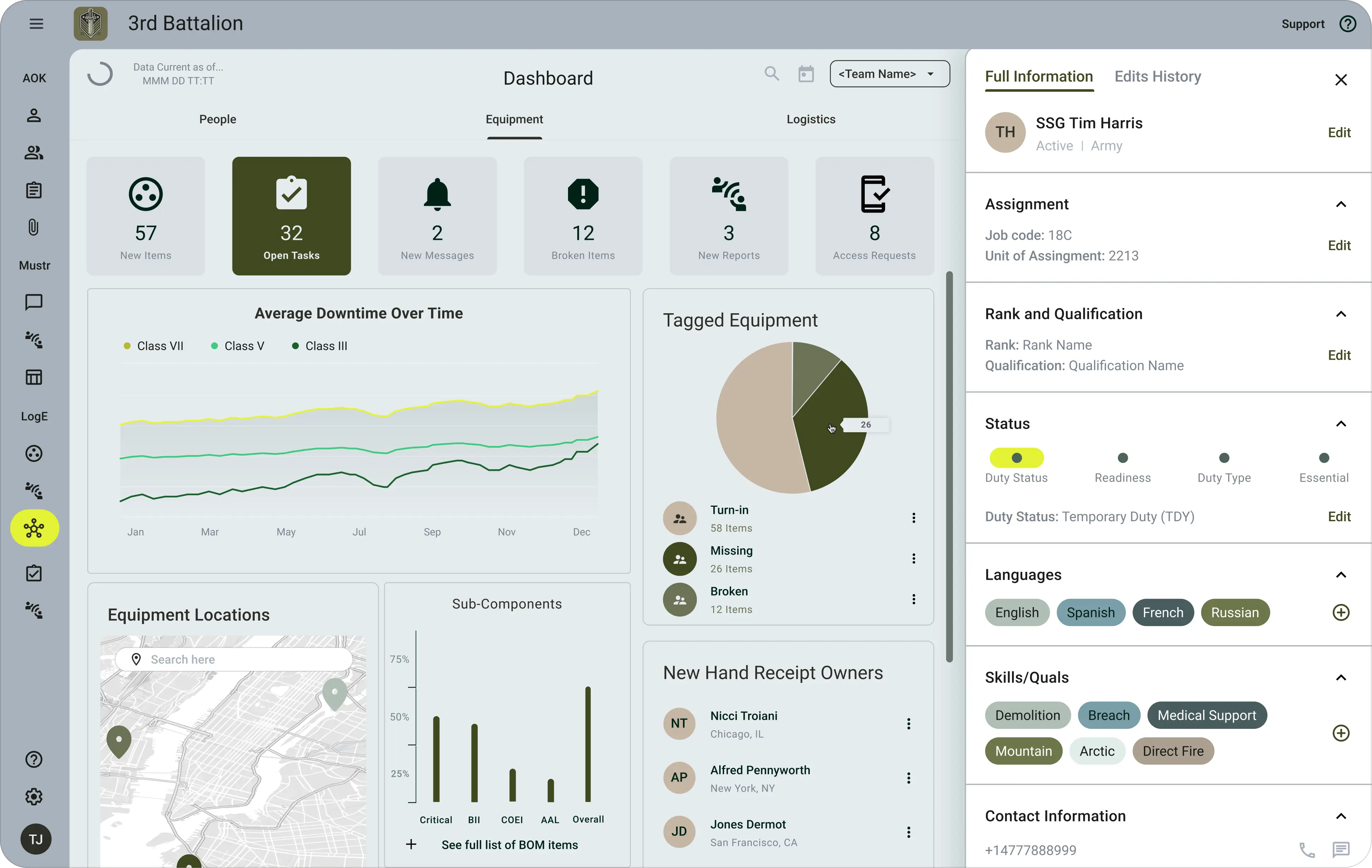As representatives of the Adyton team, my co-founder James Boyd and I are proud to announce the launch of our flagship product Mustr, a mobile-first COTS solution which has already become the go-to digital accountability tool for units across every branch of DoD.
Mustr was born amidst the uncertainty and chaos of spring 2020, when organizations all over the world were scrambling to react effectively to life in a pandemic world. It is possible that no other organization on earth was less well-suited than DoD for an abrupt shift to remote work, and what started as a kind of weekend project for a couple of our engineers has since become the centerpiece of a set of software tools that is transforming day-to-day operations for thousands of DoD personnel across dozens of units.
To understand how Mustr has become such an indispensable tool for military units, it is important first to understand exactly what the military means when it talks about this notion of accountability and also to understand the software environment which has enabled Mustr usage to expand so rapidly.
What we mean when we talk about “accountability”
As it pertains to this notion of “accountability,” for defense personnel it means a great deal more than, “Did all my people show up for work today?” In a military context, my chain of command is responsible not only for making sure that I show up for work but also that I am in reasonably good health, that I’ve had an annual physical and dental check-up, that my family has enough food to eat, that I have a childcare plan for my little ones, that my bills are paid and that my home is in good order.
It is also important to consider the demographic make-up of this defense population, where two-thirds of the workforce is in its twenties, where only one-third of the workforce has a college degree, where the aspirational benchmark is that the workforce will spend only 25% of its time away from home – and where individuals across the workforce succumb to suicide at a rate which nearly doubles the national average.
In the words of one of our early field testers, “Go all the way back to The Iliad, where Homer spends 400 verses on the Greeks’ men, weapons and equipment. Accountability is the most important thing we do - and it hasn’t changed much since The Trojan War.”
The ugly truth about workplace technology in DoD
As James and I were in the early days of building the business, we were somewhat surprised to learn the extent to which the general non-defense population misapprehends the current state of workplace technology in DoD, which is five to ten years behind civilian industries with similar personnel demographics (e.g. oil field services, heavy construction or mining).
When most people think about defense technology, they conjure up Hollywood images of infrared vision and laser-guided weapons and sophisticated GPS software. In the media, we hear about huge investments in hypersonic weapons and autonomous drones and artificial intelligence. When people think defense tech, they think Stark Industries.
In real life, the DoD is much closer to the DMV than it is to The Avengers. The networks are brittle and the systems slow and unreliable. By and large, personnel are not allowed access to basic collaboration tools like Slack, Asana, Dropbox or Zoom. Email is not considered a reliable form of communication. Most personnel do not have a laptop at home, and at work the ratio of personnel to computers is often worse than fifty to one. It is not uncommon for a service member to wait days for a turn at the computer.
To complicate things, the DoD is a fundamentally mobile organization, which is to say that most of the important things people do happen away from a computer workstation. Personnel work in airplane hangars and below deck on naval vessels and in the mountains, forests and deserts of places from Alaska to Afghanistan.
In this type of operating environment, one might expect an organization to have a robust range of mobile-first tools to help its personnel get things done. One would be mistaken. In DoD, chat on your phone is not a thing. Calendaring on your phone is not a thing. Even email on your phone is not a thing.
From a business process standpoint, DoD today is actually not much different from DoD twenty or even thirty years ago. Business gets done in person, processes and outcomes documented in PowerPoint or fillable PDF, and phrases such as, “Because we’ve always done it this way,” are treated as wisdom rather than warning.
In a pre-pandemic world, it was possible, although painful, to get business done this way. In a pandemic world, DoD’s analog approach to managing its people and getting stuff done becomes no longer tenable.
Why is defense so far behind other industries?
There are a number of very good structural reasons why the defense sector is so far behind other comparable industry verticals. Part of it is that most technology start-ups cannot afford the time investment to do business with DoD. Part of it has to do with the security and compliance requirements associated with building software for defense customers. Part of it is just that it’s actually really difficult for potential DoD customers to buy stuff, especially software.
In my view, however, the biggest challenge has less to do with contracting or compliance and more to do with empathy and a company’s ability to foster an iterative environment where service members throughout the chain of command feel empowered to speak candidly about not only what is boring or repetitive or inefficient in their day-to-day roles but also what they hope to be able to do in the future – and how better software can help deliver that aspiration.
In practice, these conversations bring to life a range of product possibilities that have meaningful impact on the job satisfaction and quality of life of millions of people in the defense community, from an E4 in the Navy who currently spends all day every Thursday of every week copy-pasting names from an Excel worksheet to a PDF template to send to the printer – to an O6 in the Air Force who is determined never to have another service member attempt suicide under her command.
What does Mustr actually do?
We often describe Mustr as a digital replication of the military orders-giving process, and our users have reported that Mustr’s communication features have enabled them to repurpose time spent on routine accountability tasks in favor of both increased training time and also more time at home with family.
We are also often quick to add more color around what Mustr is not. Mustr is not a collaboration app in the way we think of tools such as Teams or Slack or Wickr or Mattermost. Broadly speaking, these tools are at their best with groups of people who have keyboards and one or more screens and who need to work collectively against a set of tasks. Similarly, Mustr is not a messaging app, akin to things like WhatsApp or Signal, which are great for real-time chatter – but which rapidly become cumbersome for elements larger than 15-20 personnel.
Most importantly, both collaboration apps and messaging apps lack necessary features around structured data collection & aggregation among large groups of people as well as the granularity of reporting that enables Mustr to deliver value at all levels of the chain of command. Put another way, tools such as Teams or WhatsApp are less useful if I find myself having to tally the number of thumbs-up emojis or tick marks in a message thread and then transcribe the “data” into something like Excel or PowerPoint.
Mustr is something different altogether. Born out of our team’s own personal experience in the military – plus thousands of hours of interviews with uniformed personnel throughout the chain of command across all branches – plus large-scale, real-world deployments with personnel in both home and deployed environments – Mustr becomes the digital home for all of the connective tissue that enables a defense organization to work.
In Mustr, as in most military organizations, most users only speak when spoken to, and with an escalating permissions model an organization can shape Mustr to mirror how their own organization actually functions. With highly granular reporting, when 99% of things are as they should be, leaders are able to zero in on exceptions to rapidly identify the situation or service member that might require more attention. Every interaction is a secure, structured, professional business process that generates the kind of detailed operations data necessary to help an organization eliminate redundant clerical tasks and focus instead on the jobs everyone actually signed up to do.
Need a right-now snapshot of where in the world all of your personnel are located? You can get it done in seconds with Mustr. Need to put out the most recent command guidance on a policy change – with documentation that everyone in the unit has received the message? You can get it done in seconds with Mustr. Need to pull together some data for the boss on how many personnel in the unit have a foreign language proficiency – or are HAZMAT-qualified – or are good-to-go on a flight physical? You can get it done in seconds with Mustr.
Why should I get excited about a product like Mustr?
Part of what we’re trying to achieve with Mustr in particular and with our company more broadly is a change in mindset among technology users in the Department of Defense. For decades, we’ve bought our software from the same folks who built our tanks and ships and airplanes, and we’ve been conditioned to believe that it’s okay if the software is difficult to use and it’s okay if the software doesn’t do what it’s supposed to and it’s okay if the software breaks and I have to find a workaround.
With Mustr, we are saying that it doesn’t have to be that way. Software should not be difficult to use. Software should not require hours of user training or ten-pound job aide books. Software should break once per year, not once per week. And when it breaks, you should have a direct line to someone who can fix it - or at least give you an explanation - in minutes or maybe hours, rather than weeks or maybe months. Software should make your day go by faster, rather than be the reason you have to stay at work late.
To that end, as former service members with post-military careers in technology at world-class companies, James and I like to think that we are uniquely suited to help DoD navigate its digital transformation. Beyond James and myself, our team includes veterans from the Army, Navy, Air Force and Marine Corps with degrees from places like Stanford, Yale, West Point and MIT. Our secret weapon is a military spouse who recently completed her Ph.D. at Notre Dame. Our families and many of our closest friends continue to wear the uniform every day.
As members of the defense community, we understand its challenges in a way that is extremely difficult for other companies to match - and as a public benefit corporation we are grateful to invest our time and talent in a software product that makes it possible for our friends and loved ones and siblings-in-arms to do their jobs more efficiently and with less risk.
Mustr is a manifestation of our company’s mission to build world-class mobile software for people who serve. It takes a special breed of human being to become a part of the defense community and to remain part of it for any length of time. Service is a calling not everyone shares. For those who do, we are proud to introduce Mustr as the type of technology product our Soldiers and Sailors and Airmen and Marines – and even our friends in the Coast Guard and Space Force – actually deserve.
.png)















































